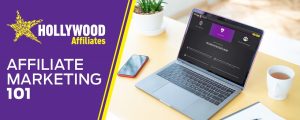Speaking the industry language is an essential part of becoming successful in the world of Affiliate Marketing. Here we’ll break down all of the terms and phrases Affiliate Marketers need to know!
301 redirect
A 301 redirect indicates a permanent redirect from one URL to another. This means that anyone who tries to navigate to an old URL will automatically be sent to a new URL. It’s also important to note that a 301 redirect passes all of the ranking power from the old URL to the new one.

A/B testing
Testing a number of different creative/copy versions in order to ascertain which one works best for a particular audience.
Above the fold
Above the fold refers to everything you see on a webpage without needing the scroll down once the page has loaded. Content and ad spaces that appear above the fold are often more expensive and are sought out by Affiliate Marketers.
Ad network
An ad network acts as an intermediary connects advertisers to publishers. They allow Media Buyers to purchase inventory through several different pricing models. With ad networks, you can bid for impressions or clicks for example.
Advertiser
This simply refers to the owner of the product being advertised. They pay affiliates based on pre-determined agreements.
Affiliate link
This is one of the most important ones to understand. An affiliate link is a unique URL that enables the advertiser to track user activity. The URL can be embedded in anchor text, a graphic or video. In the Hollywoodbets context, this tracks the entire user journey from first click and registration right the way through to deposits and bets.
Alt text
Short for alternative text. This is a phrase used to describe an image if the image fails to load. Alt text is also read aloud by screen readers for users who have accessibility problems. It’s vital to ensure that alt text is properly implemented as part of your wider SEO strategy.
Anchor text
Anchor text simply refers to the clickable words on a hyperlink.
API
API stands for Application Programming Interface. This includes a set of rules and protocols that are used in the building of GUI (graphical user interface) components in software.
Backlink
This is another crucial component of your wider SEO strategy. It refers to incoming links from other websites. Google uses backlinks to gauge your website’s authority.
Click Through Rate (CTR)
This is the ratio of clicks to impressions. It is usually displayed as a percentage.
Commission
This is the fee paid by the advertiser to the Affiliate.
Conversion Rate
The rate at which an affiliate link has led to a conversion/sale vs the times it has been viewed. This is displayed as a percentage. The calculation for this is quite simple: take the amount of sales a banner has generated and divide it by the total number of impressions. Multiply by 100 and the final answer you arrive at is the conversion rate.
Cookies
Info that your browser stores when you visit a website or click on a link. Cookies allow websites to keep track of activity as well as attributing referrals to certain affiliates.
CPA (Cost per acquisition)
This is the price that advertisers pay for each sale or sign up.
CPC (Cost per click)
The cost that advertisers pay for each click on their affiliate links.
CPL (Cost per lead)
The price that an advertiser pays for each form that visitors successfully fill out.
CPM (Cost per mile)
Refers to the price that advertisers pay for every 1000 impressions their banners/links/images get.
CPS (cost per sale)
A payment model that is used for online ads. When a product is purchased, a pre-determined amount is then paid to by the the advertiser.
CPV (cost per view)
The price that an advertiser pays an affiliate each time their ad is displayed.
Creative
Refers to any number of tools that advertisers make use of to get users to click on and take action. Examples include banners, text links, pop-ups etc.
Domain authority
A score out of 100 which predicts how well a website will rank on search engines.
GEO Target
GEO targeting allows for the targeting specific countries, provinces or even cities
Impressions
The total number of times that a banner is seen by website visitors.
Keyword
A word or phrase that users punch into search engines in order to find pages related to that particular word/phrase. SEO professionals generally incorporate these into their content in order to rank as high up the search results as possible.
Meta description
An HTML element which describes your webpage to search engines.
Meta title
The text displayed on search engine result pages as well as on browser tabs to indicate the topic of a page.
Off-page SEO
This refers to SEO factors that affect your site’s listing on search engine results. Off-site refers to the factors that you are not in control of. This includes things like link popularity for example.
On-page SEO
Unlike off-page SEO, on-page looks at factors of which you are in control of. These include things like length of content, keywords, meta descriptions etc.
Payment threshold
The amount of commission an affiliate needs to have earned before they can make a withdrawal.
Raw clicks
This shows the total number of clicks your banners/links receive, even if one user has clicked on a single link multiple times.
Search engine optimisation
A number of techniques used to maximise the number of visitors to a website by optimising the site to appear near the top of SERPs.
Traffic
A cumulative number of all users who visit a website.
Unique clicks
A reporting format that displays how many unique people click on an advert or link. This differs from raw clicks as it doesn’t take into account one person clicking on a link multiple times.
URL
Stands for Uniform Resource Locator, it’s really just a website’s address.






